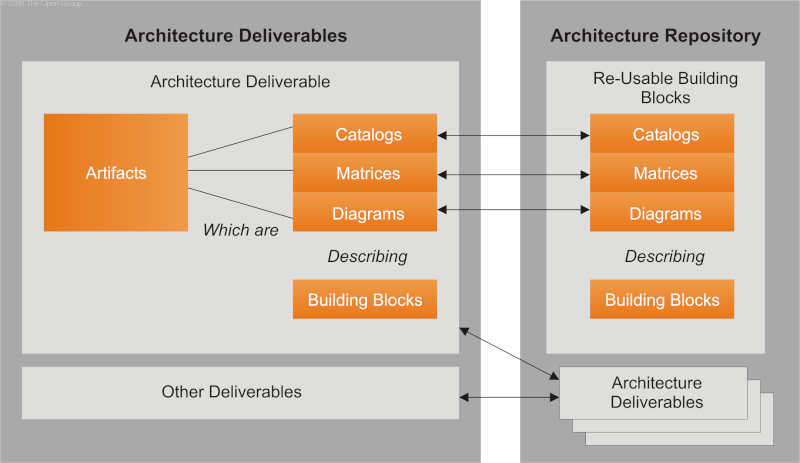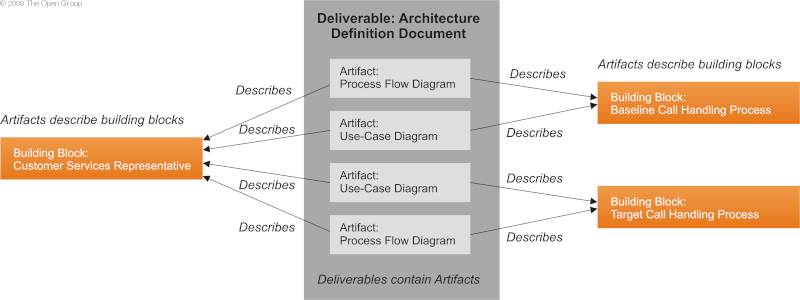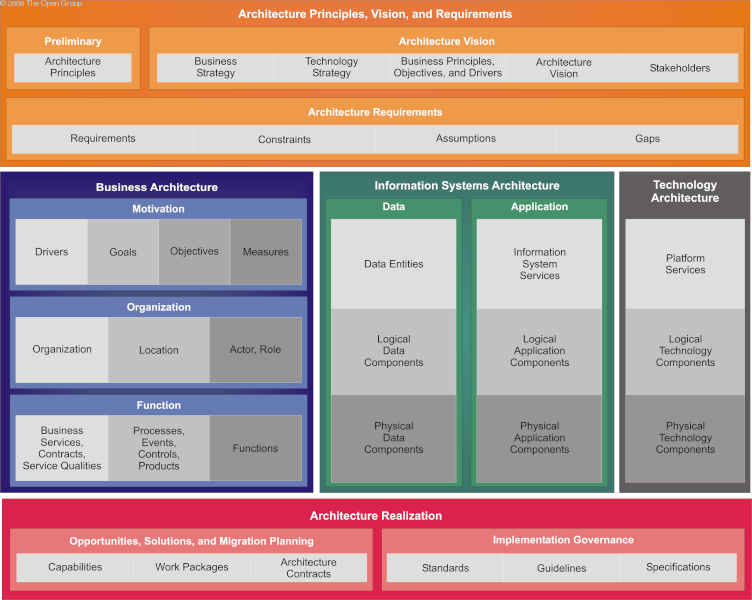
| You are here: | ||
| <<< Previous | Home | Next >>> |
Architects executing the Architecture Development Method (ADM) will produce a number of outputs as a result of their efforts, such as process flows, architectural requirements, project plans, project compliance assessments, etc. The content framework provides a structural model for architectural content that allows the major work products that an architect creates to be consistently defined, structured, and presented.
The content framework provided here is intended to allow TOGAF to be used as a stand-alone framework for architecture within an enterprise. However, other content frameworks exist (such as the Zachman Framework) and it is anticipated that some enterprises may opt to use an external framework in conjunction with TOGAF. In these cases, the content framework provides a useful reference and starting point for TOGAF content to be mapped to other frameworks.
The Architecture Content Framework uses the following three categories to describe the type of architectural work product within the context of use:
Building blocks can be defined at various levels of detail, depending on what stage of architecture development has been reached. For instance, at an early stage, a building block can simply consist of a name or an outline description. Later on, a building block may be decomposed into multiple supporting building blocks and may be accompanied by a full specification. Building blocks can relate to "architectures" or "solutions".
The relationships between deliverables, artifacts, and building blocks are shown in Relationships between Deliverables, Artifacts, and Building Blocks .

For example, an Architecture Definition Document is a deliverable that documents an architecture description. This document will contain a number of complementary artifacts that are views of the building blocks relevant to the architecture. For example, a process flow diagram (an artifact) may be created to describe the target call handling process (a building block). This artifact may also describe other building blocks, such as the actors involved in the process (e.g., a Customer Services Representative). An example of the relationships between deliverables, artifacts, and building blocks is illustrated in Example - Architecture Definition Document .

The content metamodel provides a definition of all the types of building blocks that may exist within an architecture, showing how these building blocks can be described and related to one another. For example, when creating an architecture, an architect will identify applications, "data entities" held within applications, and technologies that implement those applications. These applications will in turn support particular groups of business user or actor, and will be used to fulfil "business services".
The content metamodel identifies all of these concerns (i.e., application, data entity, technology, actor, and business service), shows the relationships that are possible between them (e.g., actors consume business services), and finally identifies artifacts that can be used to represent them.
Content Metamodel Overview shows an overview of the content metamodel.

The TOGAF ADM describes the process of moving from a baseline state of the enterprise to a target state of the enterprise. The ADM will address a business need through a process of visioning, architecture definition, transformation planning, and architecture governance. At each stage in this process, the ADM requires information as inputs and will create outputs as a result of executing a number of steps. The content framework provides an underlying structure for the ADM that defines inputs and outputs in more detail and puts each deliverable into the context of the holistic architecture view of the enterprise.
The content framework should therefore be used as a companion to the ADM. The ADM describes what needs to be done to create an architecture and the content framework describes what the architecture should look like once it is done.
Part IV: Architecture Content Framework is structured as follows:
The TOGAF document set is designed for use with frames. To navigate around the document:
Downloads of the TOGAF documentation, are available under license from the TOGAF information web site. The license is free to any organization wishing to use TOGAF entirely for internal purposes (for example, to develop an information system architecture for use within that organization). A book is also available (in hardcopy and pdf) from The Open Group Bookstore as document G091.